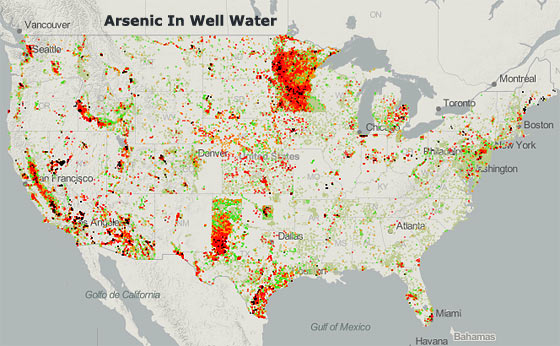Is There Arsenic In Your Well Water?
If you have a well for your drinking water, you might consider testing it for arsenic (regularly). Included as one of the many contaminants that are typically part of a ‘standard’ well water test, arsenic is something that you really want to know about – especially since you ‘might’ be slowly poisoning yourself without even knowing it…
Here’s more information including an interactive map of the United States which shows some areas which have dangerously high levels of arsenic in the wells which have been tested.
Did you know that as groundwater levels decrease, that arsenic levels may increase in surrounding wells? In fact, as the US is experiencing severe drought conditions in parts of the country, groundwater levels have indeed been falling. Particularly if you live in one of those areas, you might consider your health and safety by testing your well water for arsenic.
How does arsenic get into drinking water?
Arsenic can enter the water supply from natural deposits in the earth. It is widely believed that naturally occurring arsenic dissolves out of certain rock formations when ground water levels drop significantly.
Some industries release thousands of pounds of arsenic into the environment every year. Once released, arsenic remains in the environment for a long time. Arsenic is removed from the air by rain, snow, and gradual settling. Once on the ground or in surface water, arsenic can slowly enter ground water.
High arsenic levels in private wells may not only come from a naturally occurring condition from rocks and soil, but may also come from overuse of certain arsenic containing fertilizers or herbicides used in the past or even industrial waste.
What are the health risks of arsenic in drinking water?
“No organ system goes untouched.” Experts who study arsenic say it sweeps through our bodies, affecting organ after organ.
“We’re seeing associations with lower and lower exposure levels,” said Joseph Graziano, a professor of Environmental Health Sciences at the Mailman School of Public Health at Columbia University. “And so are we concerned about the levels that we see in the United States? Absolutely, yes.” “There’s neurotoxicity, there’s cardiovascular disease…there’s a whole suite of cancers: lung cancer, bladder cancer, skin cancer,” he said.
The table below shows the lifetime risks of dying of cancer from arsenic in tap water, based on the National Academy of Sciences’ 1999 risk estimates.
| Arsenic Level in Tap Water (in parts per billion, or ppb) |
Approximate Total Cancer Risk (assuming 2 liters consumed/day) |
| 0.5 ppb | 1 in 10,000 |
| 1 ppb | 1 in 5,000 |
| 3 ppb | 1 in 1,667 |
| 4 ppb | 1 in 1,250 |
| 5 ppb | 1 in 1,000 |
| 10 ppb | 1 in 500 |
| 20 ppb | 1 in 250 |
| 25 ppb | 1 in 200 |
| 50 ppb | 1 in 100 |
How do I test my well water for arsenic?
The best way to have your well tested is to find an accredited laboratory. Contact your State Certification Program for a list of certified laboratories and to answer technical questions.
States certify water testing laboratories and will be able to point you towards the laboratories more approximate to your location.
Here’s one link that I found on the EPA website which may be helpful:
State Certification Officers
How do I remove arsenic from my drinking water?
Boiling your water will not remove arsenic. Treating with chlorine (e.g. bleach) will not remove arsenic.
Water distillation systems (a water distiller) will successfully remove (separate) arsenic and other contaminants. Apparently reverse-osmosis systems may work to remove arsenic. And there are other specific purposed filters and filtration methods that will remove arsenic from drinking water. A web-search will reveal possibilities to consider.
The point here is to consider regularly (every few years?) testing your well water for contaminants – especially arsenic.
Interactive Map of Arsenic found in Well Water (USA)
Sourced from publicintegrity.org

